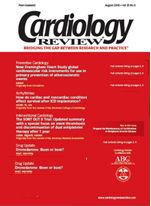Publication
Article
Cardiology Review® Online
Blood sugar management or cardiovascular risk reduction in type 2 diabetes? That is the question
What should we emphasize most in our patients with type 2 diabetes—blood sugar management or cardiovascular risk reduction? That is the question posed by Langenfeld and colleagues (Pfützner, page 30).1
In their study, they point out that most patients with type 2 diabetes die of cardiovascular disease; furthermore, many patients with type 2 diabetes present with cardiovascular disease before their blood sugar is elevated. Supporting their argument is the finding by Haffner and colleagues2 that type 2 diabetic patients at presentation are equivalent in cardiovascular risk to nondiabetic patients who have already had a myocardial infarction.
Langenfeld and co-workers1 have measured carotid intima-media thickness (IMT) in patients with type 2 diabetes and compared two blood-sugar—lowering agents: glimepiride (Amaryl) of the sulfonylurea class and pioglitazone (Actos), which is a peroxisome proliferator-activated receptor (PPAR gamma) agonist. While the sulfonylurea lowers blood sugar by stimulating insulin secretion, PPAR gamma agents affect adipose metabolism by shifting active adipose tissue to less metabolic fat. This process indirectly affects blood sugar by increasing its uptake in muscle tissue. They found that both medications had a similar effect on blood sugar at 24 weeks—glycosylated hemoglobin (A1C) –0.8 ± 0.09% with pioglitazone versus –0.6 ± 0.8% with glimepiride. Carotid IMT was reduced significantly at 12 and 24 weeks only with pioglitazone.
PPAR gamma agents such as pioglitazone affect blood sugar lowering and are also anti-atherogenic. They have several diverse effects including lowering many markers of inflammation, such as cytokines in monocytes, apoptosis in macrophages, and adhesion molecules in endothelial cells. Measurement of carotid IMT is evolving as a surrogate marker of cardiovascular risk. In addition, proinsulin, which is usually elevated in patients with type 2 diabetes, can also be measured as a marker of insulin resistance in clinical practice. It is likely that these two markers will be increasingly utilized to follow cardiovascular risk assessment in patients with type 2 diabetes.
The study of Langenfeld et al1 emphasizes that type 2 diabetes is a clinical syndrome. In some patients who tend to be thin, insulin deficiency is the major problem, and these patients will respond to sulfonylureas and insulin if necessary. More commonly in patients with type 2 diabetes, central obesity and insulin resistance are the major culprits. Treatment of these patients should emphasize better health habits, including strategies to encourage weight loss, blood pressure management, blood sugar reduction with glitazones or metformin (Glucophage, Glumetza), and appropriate lipid therapy. The available glitazones, though, have some disagreeable adverse effects, such as significant weight gain and, often, edema that is resistant to diuretic treatment.
We are at a turning point in the care of type 2 diabetes. Much recent data has shown that most patients with type 2 diabetes have an insulin-resistant state that markedly enhances cardiovascular risk. Some of these patients will develop increased blood sugar early in their course as insulin secretion is inadequate, while others may develop increased blood sugar very late. In fact, some patients will never be diagnosed with type 2 diabetes because we utilize elevated blood sugar as the defining marker of type 2 diabetes and their blood sugar is not elevated. Regardless of whether blood sugar is elevated, therefore, we need to treat our patients with insulin resistance as early and as aggressively as possible.





